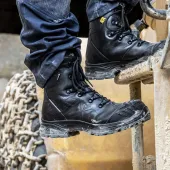Hot Bitumen Safety - Still an Issue, 11 Years On

First published in the January 2016 issue of Quarry Management
Despite clear industry guidelines published more than a decade ago and revised in 2015, Hycontrol still regularly encounter asphalt plants with insufficient safety protocols for preventing spills of hot bitumen
Recently issued information from Eurobitume UK has reinforced the need for stringent safety precautions on sites with bitumen storage facilities; key among them being the implementation of a robust level monitoring and alarm system (‘Site Inspection for the Delivery of Bitumen’, Eurobitume UK, June 2015). Eurobitume UK – formerly known as the Refined Bitumen Association (RBA) – is now the British arm of the European Bitumen Association, a consortium of major oil companies and bitumen producers, including Shell, BP, Total, ExxonMobil and Nynas.
Bitumen is pressure-delivered hot (up to 230°C) and must be stored in tanks at a constant high temperature (ranging from 125–190°C depending on the grade and type of product). As a consequence, spillages resulting from overfilling of these tanks have a high potential for causing serious injury. Whilst the risks associated with the storage of hot bitumen have been known for decades, it is only comparatively recently that clear guidelines for handling this dangerous and difficult substance have been published. The RBA first published concise guidelines for ensuring bitumen storage safety in October 2004, responding to year-on-year increases in injuries and incidents at sites across the UK, which peaked at 82 spills in 2003. The document, entitled ‘Guidance for Safe Bitumen Tank Management’, laid out issues resulting in spills:
- Ignorance of tank dimensions and capacity
- Unsuitable and unreliable measurement instrumentation
- Poor site communication.
The guide outlined the technology required to overcome these issues, the need for changes in staff attitude and training, and the requirement for clear communication. In the decade since this key document was issued there has been a sharp decline in the number of spillage events. The recent Eurobitume memorandum has served to reinforce and underline the ongoing importance of the original RBA document.
However, level-measurement experts Hycontrol say they have clear evidence that there are still a significant minority of sites making do with unreliable bitumen level control equipment, poor tank content information and outdated safety systems. These factors present a highly dangerous environment, potentially putting plant personnel and drivers at risk of receiving life-changing or even fatal injuries.
David Wadsworth, Hycontrol’s UK sales manager, is clear on the dangers: ‘Frankly, it is remarkable that, 11 years on from the RBA’s definitive statement on bitumen level monitoring and safety, we are still seeing asphalt facilities that are making do with totally outdated technology to monitor a potentially lethal substance. Plumb-bob and ‘cat-and-mouse’ pulley-based systems are still common, despite their propensity to jam or wear out.
‘All too often these devices are also expected to double as a high level alarm (HLA), or else another inappropriate technology like a float switch is used to fulfil this function. This technology is barely more advanced than the float in a domestic toilet. Again, devices like this are prone to wearing out and becoming blocked with sticky bitumen – and when they do fail, what will then stop the tank from overspilling?’
Mr Wadsworth continued: ‘What’s also clear from our site visits is that the lack of clearly displayed tank contents information continues to be a major safety issue. Site operators are now far better educated regarding capacity, knowing that there are parts of the tank that are unavailable to fill and aware of the need for a defined safety margin at the top of the tank. But danger arises if a tank is not empty and the level measuring equipment is inaccurate. In this situation operators may have a false idea of how much bitumen they can safely receive. Meanwhile, tanker drivers will know the quantity they are carrying but risk being misinformed of the available capacity in the vessel they are pumping into.’
Capacity
It is believed that prior to the RBA’s original guidelines, at least 90% of bitumen accidents were attributable to the problem of drivers and staff not understanding ‘true’ available capacity. There will always be space at the bottom of the tank, below the draw-off point, which will never be drained and must be discounted from its stated capacity. It is also not possible to fill the tank above the overfill pipe. Exceeding that level would result in a spill, but this unavailable space is still included in the vessel’s nominal capacity.
Consider the example of a bitumen tank with a stated capacity of around 100 tonnes. It can be seen from table 1 that, of the 100-tonne capacity, only 82.4 tonnes can safely be stored. It is little wonder, therefore, that misunderstandings were commonplace.
Whilst this is now largely understood by site operators and workers, any benefit it may bring is negated if the level-measurement and alarm equipment being used is unsuitable or outdated. The high-temperature, viscous characteristics of bitumen can easily cause poorly selected equipment to fail or operate erratically. Also, if it is not maintained even the most advanced technology will prove ineffective. These issues must also be addressed in order to achieve a satisfactory solution.
Accurate level measurement
The guidelines state that not only should all bitumen tanks be fitted with a reliable contents gauge that can trigger a HLA at 90% available tank capacity, but they also require a separate high-high level alarm (HHLA) that is completely independent of the contents gauge and which will trigger at 92.5% available capacity. Only by doing this can site managers and staff begin to be truly confident of their ability to accurately judge tank contents and avoid overfilling. Figure 1 shows a typical ‘good’ tank set-up.
The next important step is to choose suitable technologies for the level gauge and the HHLA. Whatever is chosen will need to withstand exposure to an extremely unpleasant, high-temperature, sticky product that coats everything it comes into contact with, or to its carbonizing vapours. There are many measuring principles marketed as being suitable for use on bitumen, but in reality few can continue to operate when coated – most fail or give false readings and alarms.
Having been consulted by the RBA throughout the compiling of their guidelines and with more than 30 years’ experience as level-measurement innovators, Hycontrol are perhaps better placed than most to point out shortcomings in bitumen level safety at sites they visit. Whilst the original guidelines list time domain reflectometry (TDR), radar and hydrostatics as suitable technologies, Hycontrol (who have conducted extensive field tests and include all three technologies in their product range) only ever offer TDR for bitumen level measurement and the high level alarm. They say experience has shown that the bitumen tank environment will inevitably coat a radar transmitter, leading to loss of function – a problem which, as will be shown below, does not affect TDR. Hydrostatic devices will function whilst submersed in bitumen, but to provide accurate level measurement they must be calibrated to the specific gravity (SG) of the liquid. The temperature of bitumen fluctuates in a tank and the SG of bitumen varies with temperature, meaning hydrostatics cannot reliably be used to trigger the HLA due to the potential variance of the actual level.
TDR technology, originally used to detect breaks in subsea communication cables, uses pulses of low-power microwaves sent along the conducting probes. In a typical bitumen application, the stainless steel probes of the TDR sensor are fitted to flanges at the top of the tanks and extend down into the product. The probes allow a very narrow measuring profile up to a maximum range of 24m, particularly useful for measurements in tanks which have internal structural supports.
At the point where the microwaves meet the air-bitumen interface, they are reflected by the bitumen back along the probe. The measured time between emission and reception back at the sensor head is proportional to the distance. This information is then converted to a 4–20mA signal which is fed to the level display.
The advantage of this technology, allowing it to overcome the inherent bitumen coating issue, is that microwaves travel virtually at the speed of light and pass over any coating on the cable with negligible effect. Periodic cleaning is recommended to prevent the coating becoming too thick, but performance is unaffected by changes in pressure, temperature or viscosity, making TDR an effective solution for hot bitumen.
An independent alarm
Eurobitume UK recommendations state the HHLA switch must be independent of the continuous level monitoring gauge. It also needs to be equally resilient to product build-up on the sensing element. Float switches and similar technologies will inevitably fail due to product coating and maintenance is an expensive issue – indeed Eurobitume guidelines no longer recommend them as a suitable technology.
Hycontrol’s extensive site experience has shown that RF admittance probes best suit the HHLA requirement as build-up on the sensor does not impede its function. A protective insulation electrode between the conventional main electrode and the grounding sleeve allows the electronics to differentiate between coating and the actual product level. Again, whilst periodic cleaning is still recommended, utilization of the correct equipment will have the added benefit of a vastly reduced maintenance requirement. Admittance probes have no moving parts and so will not wear out like old-fashioned mechanical devices.
Clear displays and clear understanding
Lastly, the Eurobitume guidance states the need for visible, unambiguous display information for both drivers and site staff. Panels should give a very clear indication of the alarms and their status, along with flashing beacons and loud sirens to alert users when an alarm level is reached. This is vital to ensure that tank integrity is maintained. Panels can also include displays of contents, ullage and tank temperature. For unmistakable clarity, a large, multi-LED traffic light can be used to indicate safe ullage for a full load (green), triggering of the HLA (amber) and triggering of the HHLA (red). Using this simple, universally understood system removes any ambiguity. Clear, easily readable safety signage is also essential.
The correct equipment is the first part of the bitumen safety puzzle. Equipment must then be correctly installed and commissioned. Regular maintenance is necessary to keep the instrumentation clean and functional, which is emphasized in the guidance. Equipment calibration must be checked and corrected to ensure that the accuracy of level readings is maintained.
Conclusion
Eurobitume UK and Hycontrol concur that maximum bitumen safety is an achievable end, but it is a multi-faceted issue requiring:
- Accurate and reliable contents measurement with unambiguous presentation of salient information
- Correct calculation of ullage using tank contents information to determine whether there is sufficient room in the tank to allow a new load to be delivered without overfilling
- Effective communication between plant personnel and bitumen tank drivers, together with strict adherence to operating procedures; and participation and commitment during the delivery and offloading process
- Provision of suitable safeguards to warn of impending overfills should something go wrong.
According to David Wadsworth of Hycontrol, despite the progress made over the last decade in educating site managers, health and safety officers and staff about tank capacities and the risks associated with bitumen storage, the suitability, reliability and accuracy of the measuring equipment they are using is sometimes still questionable at best. ‘Only through a combination of appropriate, well-maintained monitoring equipment and alert, informed site staff can we be confident in the safety of bitumen storage,’ he said.
Safety first at Newlay Asphalt
A bitumen safety system supplied by Hycontrol is ensuring Dewsbury-based Newlay Asphalt Ltd meet the latest safety guidelines. The company recently commissioned a new asphalt plant which includes two 30,000-litre horizontal bitumen storage tanks. However, the tanks were fitted with basic mechanical float meters to provide both the contents level and the high level alarm. In the event of failure of this single measuring instrument, there would be a risk of hot bitumen spillage during the filling process. As a result, Newlay Asphalt decided to invest in a Hycontrol bitumen safety system that provides continuous level measuring, a high level alarm (HLA) and a totally independent high-high level alarm (HHLA).
The Eurobitume/RBA guidelines stipulate that, in order to avoid product spillage while the delivery hose/line is being cleared, the HLA should be set to trigger an alarm at the available capacity of the tank less 10%. The HHLA should be set to warn operators that there is only 7.5% of the available tank capacity remaining.
For this particular application, the bitumen levels are measured using Hycontrol’s high-temperature VF03 TDR sensors. The 2.35m long stainless steel probes are fitted to flanges at the top of the tanks and extend down into the hot bitumen. Unlike many other level-measuring technologies, the VF03 TDR sensors are not affected by product build-up on the probes, nor is their performance affected by changes in pressure, temperature, dielectric constant or viscosity, making them a particularly suitable solution for hot bitumen.
In line with Eurobitume/RBA safety guidelines, the Hycontrol system at Dewsbury provides a secondary independent system to prevent overfilling, based on their high level ME81 capacitive sensors mounted on flanges at the top of the tank. Whereas traditional capacitance switch technology has measurement limitations, mandating that different versions are required depending on the dielectric constant and conductance of the material being monitored, Hycontrol’s advanced ME Series use the same transmitter and sensor for all applications, simplifying maintenance and minimizing inventory outlay. The two sensors are connected to a bespoke Hycontrol instrument panel featuring digital indicators displaying the levels in each tank and high level warning beacons with a lockable mute.
Newlay’s site manager, Jamie Brown, is very pleased with the Hycontrol system: ‘When the tanks arrived with basic float meters and without an independent HHLA, we decided to fit a complete new integrated system. Hycontrol were very helpful throughout the conversion process, working closely with our engineers during the commissioning process. We take health and safety matters very seriously and we are now confident that we have a fully compliant safety system.’
For more information visit: www.hycontrol.com
- Subscribe to Quarry Management, the monthly journal for the mineral products industry, to read articles before they appear on Agg-Net.com








